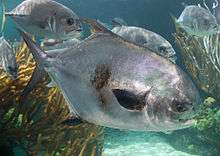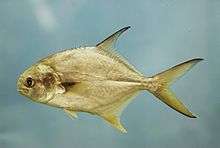Permit (fish)
The permit (Trachinotus falcatus) is a game fish of the western Atlantic Ocean belonging to the family Carangidae. Adults feed on crabs, shrimp, and smaller fish.
| Permit | |
|---|---|
 | |
| Scientific classification | |
| Kingdom: | Animalia |
| Phylum: | Chordata |
| Class: | Actinopterygii |
| Order: | Carangiformes |
| Family: | Carangidae |
| Genus: | Trachinotus |
| Species: | T. falcatus |
| Binomial name | |
| Trachinotus falcatus | |
| Synonyms[2] | |
|
Labrus falcatus Linnaeus, 1758 | |
Taxonomy
The permit was first described by the "father of taxonomy", Carl Linnaeus in his tenth edition of the work Systema Naturae, which was published in 1758. He originally classified it as Labrus falcatus, though the fish has since been placed in the genus Trachinotus.[3] It is the type species of the genus Trachinotus.[4]
Etymology
The permit's genus name, Trachinotus comes from a fusion of the Greek words trachys (τραχύς), which means "rough", and noton (νῶτον), meaning "back".[5] The species name for the permit, falcatus, is a Latin adjective, which roughly means "armed with scythes". This serves as a reference to the permit's dorsal fin that occasionally protrudes from the water when schools of permit feed near the surface.[3]
Anatomy and morphology

Permits can be distinguished by their elongated dorsal fins and anal fin.[3] The dorsal fin is shaped like a scythe. Permit tails are also deeply forked, and their bodies are compressed laterally, making the fish tall and thin when viewed from the front. [3]
The average permit has six to seven dorsal spines, and 18 to 20 one soft rays. The anal fin has two to three spines, and 16 to 18 soft rays.[2] Both dorsal and anal fins have dark, anterior lobes.[6] Permits have no scutes and have a large, orange-yellow patch on their abdomens in front of their anal fins, while their pectoral fins are dark.[7]
The permit fish can reach a maximum length of 48 in (122 cm) and can weigh up to 79 lb (36 kg), according to the Florida Museum of Natural History.
Distribution and habitat
Permit are usually found in shallow, tropical waters such as mudflats, channels, and muddy bottoms.[3][2] Although permit are found close to shore and even in some brackish areas, they spawn offshore.[6] Young are found usually in the surf zone where plenty of small invertebrates are available for them to eat.
Permit are found in the western Atlantic Ocean from Massachusetts to Brazil, including most of the Caribbean islands.[2]
Two submarines of the United States Navy were named USS Permit in its honor, in keeping with the "denizens of the deep" theme of submarine names that prevailed before the 1971 naming of USS Los Angeles.
 A permit caught off the coast of Nicaragua
A permit caught off the coast of Nicaragua
 Another, near seagrass in the Florida Keys
Another, near seagrass in the Florida Keys A wild permit off the coast of Belize
A wild permit off the coast of Belize
References
- Smith-Vaniz, W.F.; Williams, J.T.; Pina Amargos, F.; Curtis, M. & Brown, J. (2015). "Trachinotus falcatus". IUCN Red List of Threatened Species. 2015: e.T190407A16510662. doi:10.2305/IUCN.UK.2015-4.RLTS.T190407A16510662.en.
- Froese, Rainer and Pauly, Daniel, eds. (2019). "Trachinotus falcatus" in FishBase. August 2019 version.
- "Florida Museum of Natural History". Retrieved 2008-03-03.
- Eschmeyer, W. N.; R. Fricke & R. van der Laan (eds.). "Trachinotus". Catalog of Fishes. California Academy of Sciences. Retrieved 18 November 2019.
- Romero, P., 2002. An etymological dictionary of taxonomy. Madrid, unpublished.
- Smith, C.L., 1997. National Audubon Society field guide to tropical marine fishes of the Caribbean, the Gulf of Mexico, Florida, the Bahamas, and Bermuda. Alfred A. Knopf, Inc., New York. 720 p.
- Randall, J.E., 1996. Caribbean reef fishes. Third edition - revised and enlarged. T.F.H. Publications, Inc. Ltd., Hong Kong. 3rd ed. 368 p.
External links
| Wikimedia Commons has media related to Trachinotus falcatus. |
- Bonefish and Tarpon Trust
- http://fishbull.noaa.gov/1001/cra.pdf
- Photos of Permit on Sealife Collection
